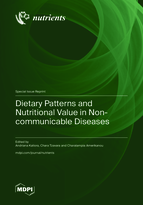Dietary Patterns and Nutritional Value in Non-communicable Diseases
A special issue of Nutrients (ISSN 2072-6643). This special issue belongs to the section "Nutritional Epidemiology".
Deadline for manuscript submissions: closed (20 September 2023) | Viewed by 38701
Special Issue Editors
Interests: dietary interventions; foods; nutrients; food supplements; dietary patterns; chronic inflammatory conditions; inflammatory diseases; oxidative stress
Special Issues, Collections and Topics in MDPI journals
Interests: biostatistics
Interests: biology; molecular nutrition; inflammation; phytochemicals; clinical trials; inflammatory diseases; obesity; epigenetics
Special Issues, Collections and Topics in MDPI journals
Special Issue Information
Dear Colleagues,
It is well known that the quality of human nutrition is fundamental to human health and affects the risk of non-communicable diseases. The global food system has been dramatically changing in recent years, which has consequences concerning the nutritional quality of foods, and consequently, the risk of NCDs. Therefore, the need for diagnostic tools to use in the evaluation of nutritional value and the improvement of nutrition counseling and disease prevention is more important than ever before.
Approaches to dietary patterns can help us understand the role of diets in NCDs and assess the quality of the existing dietary recommendations in clinical practice. Additionally, the identification of associations between dietary patterns and health risks will help us guide nutrition and public health policies.
In this Special Issue of Nutrients, we would like to bring together manuscripts that deal with the topic of “Dietary Patterns and Nutritional Value in Non-Communicable Diseases”. Topics may include the identification of dietary patterns associated with different NCDs, as well as associations between dietary patterns and the nutrient content of its constituent foods with different disease-related factors. Because identifying the molecular biomarkers related with dietary patterns may help us to understand the mechanisms underlying the diet-related risk for chronic diseases, manuscripts on the proteomic and metabolomic signatures of dietary patterns are most welcome.
Different types of manuscripts, including original clinical research articles and up-to-date reviews (systematic reviews and meta-analyses), are welcome.
Prof. Dr. Andriana Kaliora
Dr. Chara Tzavara
Dr. Charalampia Amerikanou
Guest Editors
Manuscript Submission Information
Manuscripts should be submitted online at www.mdpi.com by registering and logging in to this website. Once you are registered, click here to go to the submission form. Manuscripts can be submitted until the deadline. All submissions that pass pre-check are peer-reviewed. Accepted papers will be published continuously in the journal (as soon as accepted) and will be listed together on the special issue website. Research articles, review articles as well as short communications are invited. For planned papers, a title and short abstract (about 100 words) can be sent to the Editorial Office for announcement on this website.
Submitted manuscripts should not have been published previously, nor be under consideration for publication elsewhere (except conference proceedings papers). All manuscripts are thoroughly refereed through a single-blind peer-review process. A guide for authors and other relevant information for submission of manuscripts is available on the Instructions for Authors page. Nutrients is an international peer-reviewed open access semimonthly journal published by MDPI.
Please visit the Instructions for Authors page before submitting a manuscript. The Article Processing Charge (APC) for publication in this open access journal is 2900 CHF (Swiss Francs). Submitted papers should be well formatted and use good English. Authors may use MDPI's English editing service prior to publication or during author revisions.
Keywords
- dietary patterns
- nutritional value
- non communicable diseases
- chronic diseases
- metabolomic signatures
- proteomic signatures
- dietary asssesment
- factor analysis









